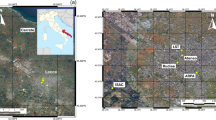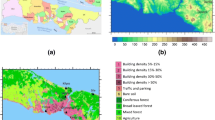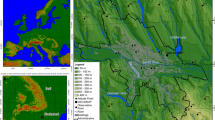Abstract
Many Mediterranean cities are currently experiencing unprecedented growth. Beyond their postcard images with charming architecture and timeless harmony, these cities have an urgent need to tackle the challenges of modernity. Their unrestricted sprawl to meet population growth and economic expansion comes at the expense of natural ecosystems and possibly contributes to the rise in temperatures locally leading to an urban heat island (UHI) in cities. Particularly, Casablanca, the largest city in Morocco, has recently undergone an important urban expansion as a result of a demographic explosion and a strong anthropic pressure, hence the need to address the impact of urban growth on its climate.
This paper aims to assess the UHI in the city of Casablanca, compare its intensity between day and night, and finally study through the different climatic changes of the four seasons.
For this, we conduct an analysis of thermal data over several temporalities: the day and the night, the equinoxes and the solstices of the four seasons and finally over a decade. Thermal data was obtained from the satellite instrument MODIS. The analysis across these temporalities leads to a series of interpretations related to several factors.
Access provided by Autonomous University of Puebla. Download chapter PDF
Similar content being viewed by others
Keywords
Introduction
The urban extension produces important and radical consequences for the human being, his environment, and precisely the urban climate. Among these consequences is the urban heat island (UHI), a situation where the cities’ or metropolitan areas’ ambient temperature is dramatically altered and becomes warmer than the surrounding rural areas [1].
If we plot an isotherm map of such a situation, the city will appear as an “island” in the background of rural temperature [2]. The UHI operates when the differences in energy and stability between urban and rural areas produce differences in the warming and cooling rates in those areas. This causes the distinctive diurnal air temperature pattern that generates the UHI, and these differences control the intensities of the UHI [3].
The UHI affects the urban quality of life through its impacts on human health, ecosystem function, local weather, and climate. There is a direct relationship between peak UHI intensity and heat-related illness and fatalities [4]. This demonstrates the importance and relevance of UHI-related studies.
In this way studies and researches follow one another to assess the UHI causes. They show that the geometry of the city, its topography, and its thermal properties are the most important factors that induce an UHI [5,6,7]. The emission of anthropogenic heat and pollution affects the UHI intensity, but its impact is weaker, and it depends on the season [6, 8].
In terms of methodology, different approaches have been used to compare temperature datasets from rural and urban stations. To carry out such analysis, we considered the following criteria:
-
1.
Rural stations must be in close proximity to the city and have similar climatic features [9].
-
2.
Taking temperatures at several points in the city [10].
-
3.
Studying the temporal series of temperature of stations that are engulfed by the city as it grows [11].
-
4.
Studying the phenomenon via satellite observations [12].
Having regard to recent studies about the increase in city temperatures and the effects of environmental issues, such as global warming on health, we conduct our study on the UHI phenomenon, which is a central topic in urban climate research.
Describing the Study Area
The city support of our study is Casablanca, a Mediterranean emerging economic capital.
Over the years this city and its region become a driving force for development, an innovation center, and an exchange hub.
The city of Casablanca is located on the Atlantic coast in the west center of Morocco; its latitude and longitude coordinates are 33.589886 north and 7.603869 west, respectively (Fig. 7.1). The area of the region of Grand Casablanca is 1117 km2 [13].
The region of Grand Casablanca concentrates nearly 19% of the national urban population. Its population is increasing, as shown in Table 7.1. The rate of urbanization is close to 92% in 2008 compared with 57% nationally [12].
The spatial distribution of the population is unequal. The districts found in the heart of the city (Casa Anfa and Al Fida Mers Sultan) are the most densely populated and concentrate around 22.2% of the total population although they occupy only about 4% of the total area of the region [12].
Historically , this city built by the Zenets of Berber origin. The name Anfa refers to the port where ships used to obtain grain from neighbouring agricultural plains.
In the fifteenth century, Anfa was destroyed by the Portuguese and forgotten for almost three centuries. In the eighteenth century, Sultan Moulay Mohammad Ben Abdellah built another port where trade with Europe and America make it a privileged cramp of the Atlantic Ocean. The sultan named the city “the white house” in Spanish “Casablanca.”
Since the twentieth century, the city knows an important influence on the urban and infrastructural side [12].
The climate of the Grand Casablanca region is oceanic: mild and rainy in winter and humid and temperate in summer with the absence of frost in winter and high humidity during the year. As for rainfall, it varies from 1 year to the next [12].
Data
The only data source for this research is satellite images from the Moderate Resolution Imaging Spectroradiometer (MODIS) aboard Aqua and Terra satellites. We chose to use the images from the Aqua satellite because of the good temporal resolution as well as the much more convenient time of passage for this study. Indeed, the Aqua satellite passes over Morocco around 1 pm and 1 am, unlike the satellite Terra which passes around 10 am and 10 pm. The study of UHI suits more to the hours of passage of Aqua. However, large spatial resolution (1-kilometer pixel) is not a problem as the study area is not a city but a region.
The day images were obtained by the services of the Royal Center for Remote Sensing (Rabat, Morocco), and the night images were obtained from NASA Land Processes Distributed Active Archive Center (LP DAAC) collections available on US Geological Survey (USGS) EarthExplorer website.
Image processing was done on ArcGIS software which generated a series of maps useful for illustration and interpretation.
Methodology
-
On the spatial scale, the study area was delineated by 20 km on both sides of the Grand Casablanca region, namely, the northeast and southwest. Thus the study area covers 345,623 Ha and has a 95 km Atlantic seafront (Fig. 7.2).
-
On the time scale, we created four landmarks spread over the year. These landmarks correspond to the equinoxes and solstices: the day number 21 of the months of March, September, June, and December. This choice is relevant because it allows excluding the effect of the hot or cold climate. The study covers one decade, from 2008 to 2018, in order to exclude the effect of a cold year or a hot year and also consider the consequences of global warming.
A small methodological arbitration was imposed against the constraints of day images. Faced with cloud masks, missing data, no coverage of the area, or unavailability of the image, the authors had to go to the next day (s) to find the information sought.
Table 7.2 shows the dates of experimentation.
For the night land surface temperature (LST) , the images were extracted from MODIS product MYD11A2 V6. This product provides in each 1-kilometer pixel an average value of clear sky LSTs during an 8-day period. Selected images are given in Table 7.3.
Results and Discussion
Reading Results by Day Versus Night
The visual analysis shows that the UHI is clearly marked at night, unlike the day when it is less intense.
The north of the study area always present a heat island when compared to its surrounding environment. This island corresponds geographically to dense urban area with the highest fraction of artificial surfaces in the study area: the city of Casablanca. This observation is maintained over the four seasons as shown in Fig. 7.3.
The maximum land surface temperature (LST) at night can reach 21 °C in against 3 ° C as a minimum.
This nocturnal aspect was seen in other cities and explained by the urban geometry and radiative exchange [14], enhanced cooling by evapotranspiration in the built environment [15], and/or landscaping and soil moisture availability [16, 17].
This conclusion has also been underlined by other authors [18, 19].
Reading Results by Seasons
Beyond the temporality day/night, we propose in the following an analysis of UHI variation across different seasons. Indeed, in autumn, the UHI is less marked in the day; the difference between the city and its periphery is not revealing, unlike at night when an island of heat appears in the most urbanized and most artificial part of the city.
In spring, the UHI is clearly marked both day and night with maximum temperatures of 32 ° C in the day (1 pm) and 16 ° C at night (1 am) as shown in Fig. 7.4.
In summer, due to the rising temperatures of this hot season, a large area of “hot” areas appears on the map. The difference center-periphery is less marked as the season is hot. At night the materials will continue to reflect the energy received during the day until the last hours of the night. In winter, contrary to the assumption of the predominance of the UHI over the seasons, the city appears colder than its periphery as shown in Fig. 7.5. Indeed because of its coastal facade, the sea breeze and the orientation of the city are favorable to the flow of wind in the city which allows ventilating and measuring less the effect of the UHI. At night the observation is the same. The UHI is still apparent with a clear differentiation between the urbanized city and its rural area.
Conclusion
This work allowed crossing the phenomenon of UHI according to two temporalities: day/night, and that of the four seasons in order to skirt the subject in its annual rate evolution. We can retain from this study:
-
In the day, the UHI is less important over the seasons unlike the night when it is a clearly visible phenomenon, marked and measured over the four seasons.
-
The UHI is a phenomenon that doesn’t depend on the seasons or more generally climate, so it is a phenomenon highly dependent on urbanization, forms, and materials of a city.
References
Gago, E. J. (2013). The city and urban heat islands: A review of strategies to mitigate adverse effects. Renewable and Sustainable Energy Reviews, 25(C), 749–758.
Montavez, J. P. (2000). A study of the urban heat island of Granada. International Journal of Climatology, 20, 899–911.
Oke, T. R. (1982). The energetic basis of the urban heat island. Quarterly Journal of the Royal Meteorological Society, 108(455), 1–24.
Oleson, K. W., Monaghan, A., Wilhelmi, O., Barlage, M., Brunsell, N., Feddema, J., Hu, L., & Steinhoff, D. F. (2005). Interactions between urbanization, heat stress, and climate change. Climatic Change, 129, 525–541.
Oke, T. R. (1981). Canyon geometry and the nocturnal Urban Heat Island. International Journal of Climatology, 10, 237–245.
Oke, T. R., Johnson, G. T., Steyn, D. G., & Watson, I. D. (1991). Simulation of surface urban heat islands under ‘ideal’ conditions at night part 2: Diagnosis of causation. Boundary-Layer Meteorology, 56(4), 339–358.
Swaid, H. (1993). Urban climate effects of artificial heat sources and ground shading by buildings. International Journal of Climatology, 13(7), 797–812.
Stanhill, G., & Kalma, J. D. (1995). Solar dimming and urban heating at Hong Kong. International Journal of Climatology, 15, 933–941.
Nasrallah, H. A., Brazel, A. J., & Balling, R. C. (1990). Analysis of the Kuwait city Urban Heat Island. International Journal of Climatology, 10, 401–405.
Moreno-Garcia, M. C. (1994). Intensity and form of the urban heat island in Barcelona. International Journal of Climatology, 14, 705–710.
Jones, P. D., Groisman, P. Y., Coughlan, M., Plummer, N., Wong, W.-C., & Karl, T. R. (1990). Assessment of urbanization effects in time series of surface air temperature over land. Nature, 347, 169–177.
Lee, H. Y. (1984). An application of NOAA AVHRR thermal data to the study of the Urban Heat Island. Atmospheric Environment, Part B. Urban Atmosphere, 27(1), 1–13.
Casablanca Monograph. (2010). Office of the High Commissioner for Planning. Casablanca: Grand Casablanca Regional Office.
Nakata, C. M., & de Souza, L. C. L. (2013). Verification of the influence of urban geometry on the nocturnal heat island intensity. Journal of Urban and Environmental Engineering, 7(2), 286–292.
Yang, J., Wang, Z.-H., Chen, F., Miao, S., Tewari, M., Voogt, J., & Myint, S. (2015). Enhancing hydrologic modeling in the coupled Weather Research and Forecasting − urban modeling system. Boundary-Layer Meteorology, 155(1), 87–109.
Wang, Z.-H. (2014). A new perspective of urban-rural differences: The impact of soil water advection. Urban Climate, 10, 19–34.
Wand, Z. H. (2017). Thermodynamic characterisation of urban nocturnal cooling. Heliyon, 3, e00290.
Chow, W. T. L., Brennan, D., & Brazel, A. J. (2012). Urban heat island research in Phoenix Arizona: Theoretical contributions and policy applications. Bulletin of the American Meteorological Society, 93(4), 517–530.
Song, J., & Wang, Z.-H. (2016). Evaluating the impact of built environment characteristics on urban boundary layer dynamics using an advanced stochastic approach. Atmospheric Chemistry and Physics, 16, 6285–6301.
Acknowledgments
The authors are grateful for the Royal Center for Remote Sensing for having provided the necessary satellite images for the study as well as an internship for an author.
Author information
Authors and Affiliations
Editor information
Editors and Affiliations
Rights and permissions
Copyright information
© 2020 Springer Nature Switzerland AG
About this chapter
Cite this chapter
El Ghazouani, L., Mansour, M., Lachir, A., Smiej, M.F., Laaroussi, N. (2020). The Diurnal and Nocturnal Aspects of Urban Heat Island During the four Seasons—Case of Casablanca. In: Sayigh, A. (eds) Green Buildings and Renewable Energy. Innovative Renewable Energy. Springer, Cham. https://doi.org/10.1007/978-3-030-30841-4_7
Download citation
DOI: https://doi.org/10.1007/978-3-030-30841-4_7
Published:
Publisher Name: Springer, Cham
Print ISBN: 978-3-030-30840-7
Online ISBN: 978-3-030-30841-4
eBook Packages: EnergyEnergy (R0)









